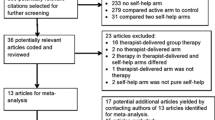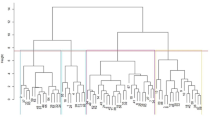Abstract
This study compared the therapeutic progress of three randomly assigned groups (n=14 in each group) of community mental health center clients: (a) clients who viewed a slide/sound presentation about all available therapists and chose their own therapist; (b) clients who viewed the presentation and were assigned to a therapist by the center's clinical director; (c) clients who were assigned to a therapist by the clinical director without seeing the presentation. There were no significant differences among the three groups in their initial reaction to the clinic, number of therapy sessions, type of termination, severity of presenting problems, General Well-Being Schedule scores, Current Adjustment Rating Scale scores, or therapist's satisfaction with therapy. Further analysis revealed that three out of four clients had improved significantly as a result of therapy. It was concluded that in the absence of research evidence demonstrating the efficacy of client choice on therapy outcome, support for the notion of client choice must be based solely on social, ethical, and legal considerations.
Similar content being viewed by others
References
Berzins, J.I.. Therapist-patient matching. In A.S. Gurman & A.M. Razin (Eds.),Effective Psychotherapy. New York: Pergamon Press 1977.
Berzins, J.I., Bednar, R.L., & Severy, L.J.. The problem of intersource consensus in measuring therapeutic outcomes: New data and multivariate perspectives.Journal of Abnormal Psychology, 1975,84, 10–19.
Brattle, C.C., Imber, S.D., Hoehn-Saric, R., Stone, A.R., Nash, E.R. & Frank, J.D.. Target complaints as criteria of improvement.American Journal of Psychotherapy, 1966,20, 184–192.
Brown, J.E. The effect of client choice of a counselor on the subsequent counseling relationship. (Doctoral dissertation, Ball State University. 1977).Dissertation Abstracts International, 1978,39(1-A), 124. (University Microfilms No. 78102776).
Coyne, J.C., & Widiger, T.A.. Toward a participatory model of psychotherapy.Professional Psychology, 1978,9, 700–710.
Dayton, C.M.:Design of educational experiments. New York: McGraw-Hill, 1970.
Devine, D.A., & Fernald, P.S.: Outcome effects of receiving a preferred, randomly assigned, or non-preferred therapy.Journal of Consulting and Clinical Psychology, 1973,41 104–107.
Dupuy, H.J.Self-representations of general psychological well-being of American adults. Revision of paper given at American Public health Association meeting on October 17, 1978, Los Angeles, California.
Enright, J.. One step forward: situational techniques for altering motivation for therapy.Psychotherapy: Theory, Research and Practice 1975,12, 344–347.
Ersner-Hershfield, S., Abramowitz, S.I., & Baren, J.. Incentive effects of choosing a therapist.Journal of Clinical Psychology, 1979,35, 404–407.
Ewing, J.A.. Matching therapy and patients: The cafeteria plan.British Journal of Addiction, 1977,72, 13–18.
Fazio, A.F.A concurrent validational study of the NCHS General Well-Being Schedule. Department of Health, Education and Welfare, No. (HRA) 78-1347, 1977.
Ferreira, A.H. The effects of client choice of counselor on counseling readiness under two conditions of expectancy treatment (Doctoral dissertation, Indiana State University, 1975).Dissertation Abstracts International, 1976,36(7-A), 4256–4257 (University Microfilms No. 75-29, 873).
Fiester, A.R.. Goal attainment and satisfaction scores for CMHC clients.American Journal of Community Psychology, 1979,7, 181–188.
Flesch, R. A new readability yardstick,Journal of Applied Psychology, 1948,32 221–233.
Gordon, R.M.. Effects of volunteering and responsibility on the perceived value and effectiveness of a clinical treatment.Journal of Consulting and Clinical Psychology, 1976,44, 799–801.
Hartlage, L.C. & Sperr, E.V.. Patient preferences with regard to ideal therapist characteristics.Journal of Clinical Psychology 1980,36, 288–291.
Hays, W.L.:Statistics for the social sciences (2nd ed.). New York: Holt, Rinehart and Winston, 1973.
Lazare A., Cohen, F., Jacobson, A.M., Williams, M.D., Mignone, R.J., & Zisook, S.. The walk-in patient as customer: A key dimension in evaluation and treatment.American Journal of Orthopsychiatry, 1972,42, 872–883.
Lieberman, M.. Some limits to research on T groups.Journal of Applied Behavioral Science, 1975,11, 241–249.
Luborsky, L., Chandler, M., Auerbach, A.H., Cohen, J., & Bachrach, H.M.. Factors influencing the outcome of psychotherapy: A review of quantitative research.Psychological Bulletin, 1971,75, 145–185.
Moore, G.R. Client choice of counselor relative to client satisfaction, counselor satisfaction, and the quality of the counseling relationship. (Doctoral dissertation, The Pennsylvania State University, 1976).Dissertation Abstracts International, 1977,37(7-A), 4137–4138 (University Microfilms No. 76-29, 659).
Nuttey, N.J.Roche report: Frontiers of hospital psychiatry. Roche Laboratories, 1969,6, No. 20.
Orlinsky, D.E., & Howard, K.I.. The relation of process to outcome in psychotherapy In S.L. Garfield & A.E. Bergin (Eds.),Handbook of psychotherapy and behavior change: an empirical analysis (2nd ed.), New York: John Wiley&Sons, 1978.
Palmer, T.B. Matching worker and client in corrections.Social Work, 1973,18, 95–103.
Parloff, M.B., Waskow, I.E. & Wolfe, B.E. Research on therapist variables in relation to process and outcome. In S.L. Garfield & A.E. Bergin (Eds.)Handbook of psychotherapy and behavior change: an empirical analysis (2nd ed.).New York:John Wiley & Sons, 1978.
Report to the President from the President's Commission on Mental Health (Vol. I) Washington, D.C.: U.S. Government Printing Office, 1978.
Rice, J.K., & Rice, D.G.. Implications of the woman's liberation movement for psychotherapy.American Journal of Psychiatry, 1973,130, 191–196.
Rosen, A.. Client preferences: An overview of the literature.Personnel and Guidance Journal, 1967,45, 785–789.
Ross, M.B.. Discussion of similarity of client and therapist.Psychological Reports, 1977,40, 699–704.
Sadoff, R.L., & Kopolow, L.E.. The mental health professional's role in patient advocacy. In L.E. Kopolow & H. Bloom (Eds.),Mental health advocacy: An emerging force in consumers' rights (DHEW Publication No. ADM 77-456). Washington, D.C.: U.S. Government Printing Office, 1977.
Siegel, S.Nonparametric statistics for the behavioral sciences New York: McGraw-Hill, 1956.
Simon, W.E.. Age, sex, and title of therapist as determinants of patients' preferences.Journal of Psychology, 1973,83, 145–149.
Sloane, R.B., Staples, F.R., Cristol, F.R., Yorkston, N.J., & Whipple, K.Psychotherapy versus behavior therapy. Cambridge, Massachusetts: Harvard University Press, 1975.
Strupp, H.H., & Bergin, A.E.. Some empirical and conceptual bases for coordinated research in psychotherapy: A critical review of issues, trends, and evidence.International Journal of Psychiatry, 1969,7, 18–90.
Tatsuoka, M.M..Multivariate analysis. New York: John Wiley & Sons, 1971.
Truax, C.B.The Current Adjustment Rating Scale. Printed test publication. Arkansas Rehabilitation Research and Training Center, University of Arkansas, 1968.
Weinrach, S.G., & Morgan, L.B.. A bill of client rights and responsibilities.Personnel and Guidance Journal, 1975,53, 557–562.
winborn, B.B.. Honest labeling and other procedures for the protection of consumers.Personnel and Guidance Journal, 1977,56, 206–209.
Winer, B.J..Statistical principles in experimental design (2nd ed.). New York: McGraw-Hill, 1971.
Author information
Authors and Affiliations
Rights and permissions
About this article
Cite this article
Manthei, R.J., Vitalo, R.L. & Ivey, A.E. The effect of client choice of therapist on therapy outcome. Community Ment Health J 18, 220–229 (1982). https://doi.org/10.1007/BF00754338
Issue Date:
DOI: https://doi.org/10.1007/BF00754338




